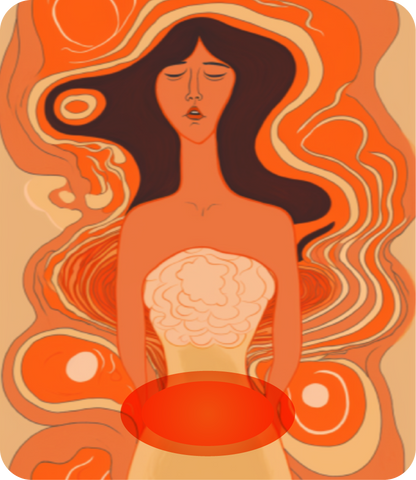
Fundamentals of Hormone Imbalance During Cycle
The menstrual cycle is a complex process that occurs in women of reproductive age. It is driven by a precise interplay of hormones, primarily estrogen and progesterone. Testosterone, cortisol, and thyroid hormones also have a relevant role in this repeating loop.
Hormonal imbalance during the menstrual cycle can lead to a variety of symptoms, including mood swings, fatigue, and irregular periods. Any tiny disruption of these hormones can be responsible for different imbalances.
Estrogen
It is a hormone produced predominantly by the ovaries and is in charge of regulating the menstrual cycle and promoting the growth and development of female reproductive organs.
It's the hormone that gives rise to feminine characteristics like breasts, hips, and higher levels of subcutaneous fat. Estrogen levels fluctuate throughout the menstrual cycle, with levels increasing during the follicular phase and decreasing during the luteal phase.
Low levels of estrogen can lead to symptoms such as hot flashes, vaginal dryness, and mood swings, while high levels of estrogen can lead to symptoms such as breast tenderness and bloating. For example, many women experience bloating and breast tenderness during the premenstrual phase of their cycle due to a rise in estrogen levels. On the other hand, postmenopausal women may experience vaginal dryness and hot flashes due to a decrease in estrogen levels.
Progesterone
Progesterone is a hormone that is also mainly produced by the ovaries and is responsible for preparing the uterus for pregnancy.
Progesterone levels increase during the luteal phase of the menstrual cycle and decrease during menstruation. The sharp drop in estrogen prior to your period is what triggers the shed of uterine lining and the onset of menstruation. Progesterone helps to balance out the effects of estrogen on the body.
Low levels of progesterone can lead to symptoms such as irregular periods and infertility, while high levels of progesterone can lead to symptoms such as bloating and breast tenderness. Persons with wombs can experience bloating and breast tenderness during the premenstrual phase of their cycle and may have higher-than-normal levels of progesterone.
Related to: The Progesterone Puzzle: How to Naturally Increase Your Levels and Feel Yourself
Testosterone
Testosterone, often associated with males but present in smaller amounts in females, serves vital functions in women's bodies. It contributes to sexual desire (libido), playing a role in both men and women.
Additionally, it supports bone health by preserving bone density and strength, and aids in the development and maintenance of lean muscle mass and physical strength.
Testosterone also affects energy levels, combating fatigue, while contributing to mood regulation and cognitive function. Furthermore, it plays a role in maintaining cardiovascular health by assisting in the upkeep of healthy blood vessels and blood flow.
While primarily produced by the ovaries and adrenal glands, testosterone's significance extends beyond gender distinctions, impacting various aspects of women's overall well-being. Its influence on sexual desire and energy levels, along with its contributions to bone density, muscle strength, and cardiovascular health, underscores its importance. Moreover, testosterone's role in mood regulation and cognitive function further highlights its intricate involvement in maintaining optimal physiological and psychological function in women.
Cortisol
Cortisol, often referred to as the "stress hormone," plays a crucial role in the functioning of a woman's body and has notable effects on menstrual health. Produced by the adrenal glands in response to various stressors, cortisol helps regulate a range of physiological processes, including metabolism, immune response, and the sleep-wake cycle.
In a person with a balanced cortisol production, cortisol levels fluctuate throughout the day in a pattern known as the circadian rhythm, with the highest levels typically occurring in the early morning and the lowest at night. S
The relationship between cortisol and menstrual health is intricate.
Elevated cortisol levels due to chronic stress can disrupt the delicate balance of hormones involved in menstruation, potentially leading to irregular menstrual cycles or even missed periods.
This is because cortisol interacts with the hypothalamus and pituitary glands, which are responsible for controlling the release of reproductive hormones like estrogen and progesterone.
High levels of cortisol can inhibit the production of gonadotropin-releasing hormone (GnRH), which subsequently affects the secretion of luteinizing hormone (LH) and follicle-stimulating hormone (FSH). These disruptions can disrupt ovulation and the overall menstrual cycle, causing irregularities and impacting fertility.
Furthermore, prolonged periods of high cortisol levels can also contribute to conditions like Polycystic Ovary Syndrome (PCOS) and hypothalamic amenorrhea, both of which can lead to menstrual irregularities and difficulties in conception. Chronic stress and increased cortisol production can create a state of hormone imbalance, where the body prioritizes survival mechanisms over reproductive functions. This can result in delayed or absent ovulation, changes in menstrual flow, and increased risk of conditions like premenstrual syndrome (PMS).
Related to: Fighting Burnout With Blue Vervain
Thyroid Hormones
Thyroid hormones play a critical role in regulating various bodily functions, including metabolism, energy production, and overall hormonal balance. In women, these hormones, namely triiodothyronine (T3) and thyroxine (T4), exert significant influence on menstrual health. The thyroid gland, situated in the neck, produces these hormones under the control of the pituitary gland.
Thyroid hormones have a direct impact on the menstrual cycle by influencing the hypothalamus-pituitary-ovary axis, which is responsible for regulating the reproductive system. Thyroid hormones help maintain the delicate balance of other reproductive hormones, such as follicle-stimulating hormone (FSH) and luteinizing hormone (LH), which are crucial for follicular development and ovulation. Imbalances in thyroid hormones can disrupt this delicate interplay, potentially leading to irregular menstrual cycles, anovulation (lack of ovulation), or even amenorrhea (absence of periods).
Furthermore, thyroid hormones play a role in maintaining the overall health of the endometrium (the lining of the uterus), which is crucial for the successful implantation of a fertilized egg. Insufficient levels of thyroid hormones can result in inadequate endometrial development, compromising the chances of conception and increasing the risk of early pregnancy loss. Conversely, excessive thyroid hormone levels can also disrupt menstrual patterns and lead to fertility issues.
Conclusion
Hormonal imbalances during the menstrual cycle can lead to a variety of symptoms and impact overall health. Understanding the role of hormones in the body and identifying potential imbalances can help individuals take steps to restore balance and improve their overall health.
It's important to note that hormone levels can vary greatly between individuals and can also fluctuate throughout the menstrual cycle. Monitoring symptoms and tracking menstrual cycles can help individuals identify potential imbalances and seek appropriate medical treatment.
In addition to medical treatment, lifestyle factors such as exercise, nutrition, and stress management can also play a role in regulating hormone levels and improving overall health. For example, regular exercise has been shown to improve insulin sensitivity and regulate cortisol levels, while a diet rich in whole foods and nutrients can support hormonal balance.
By understanding the fundamentals of hormone imbalance during the menstrual cycle and taking steps to restore balance through medical treatment and lifestyle changes, individuals can improve their overall health and well-being.
Related to: How does period syncing work?
Sources
Eva Montero-López, Ana Santos-Ruiz, M. Carmen García-Ríos, Manuel Rodríguez-Blázquez, Heather L. Rogers, María Isabel Peralta-Ramírez, The relationship between the menstrual cycle and cortisol secretion: Daily and stress-invoked cortisol patterns, International Journal of Psychophysiology, Volume 131, 2018, Pages 67-72, ISSN 0167-8760, https://doi.org/10.1016/j.ijpsycho.2018.03.021.
Nancy A. Phillips, Gloria A. Bachmann, Genitourinary syndrome of menopause: Common problem, effective treatments, Cleveland Clinic Journal of Medicine May 2018, 85 (5) 390-398; DOI: 10.3949/ccjm.85a.15081
Vigil P, Blackwell LF, Cortés ME. The Importance of Fertility Awareness in the Assessment of a Woman's Health a Review. Linacre Q. 2012 Nov;79(4):426-450. doi: 10.1179/002436312804827109. Epub 2012 Nov 1. PMID: 30082987; PMCID: PMC6027096.














































